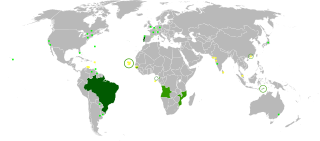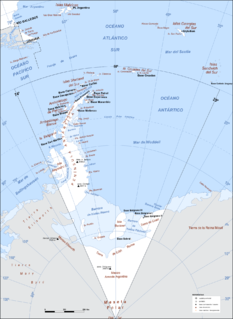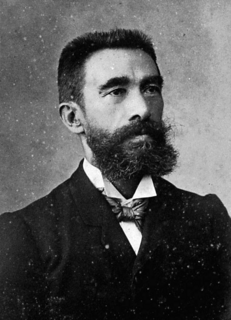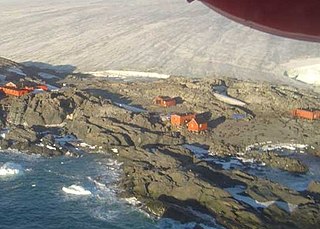| Refuge Astronomer Cruls Refúgio Astrônomo Cruls | |
|---|---|
| Antarctic station | |
Location of Refuge Astronomer Cruls in Antarctica | |
| Coordinates: 62°14′34″S58°58′49″W / 62.242819°S 58.980412°W Coordinates: 62°14′34″S58°58′49″W / 62.242819°S 58.980412°W | |
| Country | |
| Location in Antarctica | Nelson Island South Shetland Islands Antarctica |
| Administered by | Brazilian Antarctic Program |
| Established | 25 January 1985 |
| Elevation | 15 m (49 ft) |
| Population | |
| • Total |
|
| Time zone | UTC-3 (BRT) |
| Type | Seasonal |
| Period | Summer |
| Status | Operational |
| Website | PROANTAR |
Refuge Astronomer Cruls (Portuguese : Refúgio Astrônomo Cruls) is a Brazilian Antarctic summer facility named after astronomer Luis Cruls who set up an expedition in 1882 to Punta Arenas in order to observe the passage of Venus across the disk of the Sun. [1] The structure, established on 25 January 1985, is situated on Nelson Island (South Shetland Islands), southwest of King George Island, South Shetland Islands, Antarctica.

Portuguese is a Western Romance language originating in the Iberian Peninsula. It is the sole official language of Portugal, Brazil, Cape Verde, Guinea-Bissau, Mozambique, Angola, and São Tomé and Príncipe. It also has co-official language status in East Timor, Equatorial Guinea and Macau in China. As the result of expansion during colonial times, a cultural presence of Portuguese and Portuguese creole speakers are also found in Goa, Daman and Diu in India; in Batticaloa on the east coast of Sri Lanka; in the Indonesian island of Flores; in the Malacca state of Malaysia; and the ABC islands in the Caribbean where Papiamento is spoken, while Cape Verdean Creole is the most widely spoken Portuguese-based Creole. Reintegrationists maintain that Galician is not a separate language, but a dialect of Portuguese. A Portuguese-speaking person or nation is referred to as "Lusophone" (Lusófono).

Brazil, officially the Federative Republic of Brazil, is the largest country in both South America and Latin America. At 8.5 million square kilometers and with over 208 million people, Brazil is the world's fifth-largest country by area and the fifth most populous. Its capital is Brasília, and its most populated city is São Paulo. The federation is composed of the union of the 26 states, the Federal District, and the 5,570 municipalities. It is the largest country to have Portuguese as an official language and the only one in the Americas; it is also one of the most multicultural and ethnically diverse nations, due to over a century of mass immigration from around the world.

Punta Arenas is the capital city of Chile's southernmost region, Magallanes and Antartica Chilena. The city was officially renamed as Magallanes in 1927, but in 1938 it was changed back to "Punta Arenas". It is the largest city south of the 46th parallel south, and at the same time the most populous southernmost city in Chile and in the Americas, and due its location, the coldest coastal city with more than 100,000 inhabitants in Latin America. It is also one of the most populous sites so to the south of the world.
The refuge, which can accommodate up to 6 scientists for up to 40 days, [2] depends both logistically and administratively on Comandante Ferraz station. Together with Refuge Emílio Goeldi, located on Elephant Island, constitute the basic infra-structure to support the Brazilian Antarctic Program in Antarctica.

Refuge Emílio Goeldi is a Brazilian Antarctic summer facility named after the Swiss-Brazilian naturalist and zoologist Émil Goeldi. Built in 1988, the structure is located on Elephant Island, South Shetland Islands, Antarctica.

Elephant Island is an ice-covered mountainous island off the coast of Antarctica in the outer reaches of the South Shetland Islands, in the Southern Ocean. Its name was given by early explorers sighting elephant seals on its shores. The island is situated 245 kilometres north-northeast of the tip of the Antarctic Peninsula, 1,253 kilometres west-southwest of South Georgia, 935 kilometres south of the Falkland Islands, and 885 kilometres southeast of Cape Horn. It is within the Antarctic claims of Argentina, Chile and the UK. Brazil has a shelter on the island, Goeldi, supporting the work of up to six researchers each during the summer and had another (Wiltgen), which was dismantled in the summer of 1997/98.

The Brazilian Antarctic Program is a program of the Brazilian Navy which has presence in the continent of Antarctica. It coordinates research and the operational support for research in the region. It currently maintains a year-round research station in Antarctica, as well as several seasonal field camps. It also maintains two research vessels that sail in the Antarctic waters.












